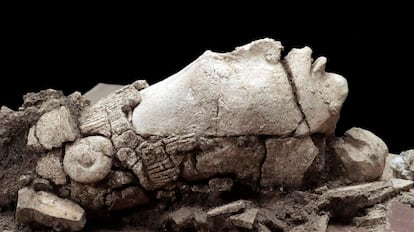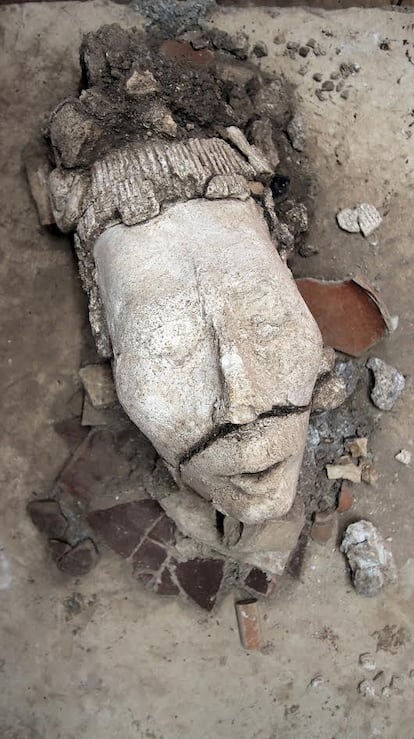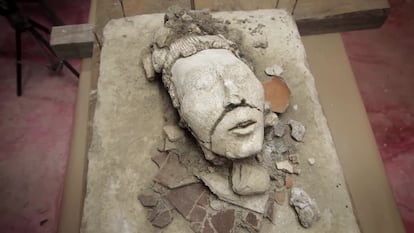Head of Mayan maize god discovered in Mexico after 1,300 years
Archaeologists found the representation of the deity during conservation work at the pre-Hispanic site of Palenque in Chiapis

For the ancient Mayans, corn was the vital plant par excellence. The Popol Vuh, their sacred text, told that the gods created humans out of its dough, after first attempting to make them from mud and wood. Only those made from corn dough survived; only they had the power to worship the gods, thank them for their creation and serve them. The human figure, the story goes, was molded out of white corn, and its blood came from red corn. Alberto Ruz Lhuillier, known for having discovered the tomb of the ruler Pakal the Great in Palenque’s Temple of the Inscriptions, explains in his book The Mayas that the people represented the corn god as “a young man, whose elongated head resembles the shape of a cob and is surrounded by leaves.” Just a few months ago, specialists from the National Institute of Anthropology and History (INAH) found such a representation of the young Mayan corn god during conservation work in a corridor of Palenque’s El Palacio, in the southern Mexican state of Chiapas. The artifact is more than 1,300 years old and is the first stucco head to be discovered at the archaeological site. The sculpture is part of an elaborate offering in a pond. “The discovery of the deposit allows us to begin to understand how the ancient Maya of Palenque constantly relived the mythical passage about the birth, death and resurrection of the maize deity,” explains INAH Chiapas Center researcher Arnoldo Gonzalez Cruz.
The head of the corn god is 45 centimeters long, 16 centimeters wide and 22 centimeters high. It is in the shape of a young man with a pronounced cranial deformation. It resembles a corncob, and its long hair imitates the shape of corn silk. “The sculpture, which must have been modeled around a limestone support, has graceful features: the chin is sharp, pronounced and split; the lips are thin and project outwards; the lower lip is angled slightly downward, and the upper incisors are visible. The cheekbones are fine and rounded, and the eyes are elongated and thin. A wide and pronounced nose comes out of the long, wide, flattened rectangular forehead,” describe the archaeologists Carlos Varela Scherrer and Wenceslao Urbina Cruz, who supervised the dig as field leaders. Due to the ceramic type of the tripod plate that accompanied the head of the “young tonsured maize god”– a description that alludes to the deity’s trimmed hair, which is reminiscent of mature maize – the archaeological piece has been dated to the Late Classic period (700-850 AD).

The sculpture was discovered inside a semi-square receptacle formed by three walls, one meter wide by three meters long. Its nose and half-open mouth emerged from under a layer of loose earth. When discovered, the head lay inside the pond on an east-west orientation, symbolizing the birth of the corn plant with the first rays of the sun. According to the researchers, for the Mayans, the pond functioned as a water mirror that reflected the sky back to them. As the archaeological exploration progressed, it became clear that the sculpture was the center of a rich offering placed on a pond, emulating the entry of this god into the underworld. In Mayan mythology, as the personification of the sown grain, the god performs various rites in the underworld. According to the myth, “[the Mayan god] travels in a canoe driven by the rowing gods, is dressed by young naked women, and finally germinates from the shell of a turtle, a symbol of the earth. In this last act, he appears flanked by two gods, Hun Ajaw and Yax B’alam, who are believed to be the version of the hero twins, Hunajpu and Xb’alanke, of the Popol Vuh, sons of Hun Junajpu,” explains archaeologist Tomás Pérez Suárez, from the Center for Mayan Studies of the Institute of Philological Research at the National Autonomous University of Mexico.

Nocturnal rituals at the pond likely began in the governance of K’inich Janaab’ Pakal I (615-683 AD) and continued during those of K’an Bahlam II (684-702 AD), K’an Joy Chitam II (702-711 AD) and Ahkal Mo’ Nahb’ III (721-736 AD). Eventually, perhaps during the reign of Ahkal Mo’ Nahb’ III, the inhabitants of Palenque symbolically closed the space, breaking a portion of the stucco floor of the pond and depositing in it a series of elements: vegetables, bones from quail, turtles, fish and domestic dogs, shells, carved bone fragments, ceramic pieces, pieces of miniature anthropomorphic figurines, 120 obsidian blades, green stone beads and shell beads, as well as seeds and small snails.

“The placement of these elements was concentric, covering almost 75% of the cavity, which was sealed with loose stones. Some animal bones were cooked, and others have flesh marks and tooth prints, so they were surely used for human consumption as part of the ritual,” says specialist Arnoldo González Cruz. A perforated limestone slab – 85 centimeters long by 60 centimeters wide and four centimeters thick – was placed on top of the offering, after the tripod plate was broken almost in half and one of its pieces was placed in the hole in the slab. Above the slab lay a semicircular bed of potsherds and small stones, on which the head of the deity was placed, supported by the same materials. The entire space was sealed with earth and three small walls, leaving the head of the young maize god inside a kind of box, where it remained hidden for 1,300 years.
“The piece is quite fragmented. It was found in a context of humidity, so it had to be allowed to dry gradually, so that the piece would not deteriorate with such a drastic change of environment, since it was flooded with water. Now, it is already in a much drier state, allowing its restoration to begin. What we are going to do is clean and then try to adhere all the fragments and to rescue all the other ceramic fragments found with the piece,” explains restorer Jorge Alejandro Coraza, referring to the fragments of the plate on which the sculpture appeared, since he “was originally conceived as a severed head.” Such representations of the young maize god appear in other pieces and documents, such as a series of plates from the Late Classic period (600-850 AD), a vessel from the Tikal region, from the Early Classic period (150-600 AD), and representations in the Dresden and Madrid codices, in which the deity, or characters linked to it, appear with their heads cut off.
“This is the account of when all is still silent and placid. All is silent and calm. Hushed and empty is the womb of the sky,” begins the Popol Vuh. First, it goes on to tell, the gods created men out of clay. It didn’t work. They fell apart when it rained, and they were unable to speak and reproduce. Then the gods tried to use wood, but the men had no soul or memory; they could not remember who their creators were. Lastly, they tried corn. That version finally worked. From those corn people was born the first human society capable of accurately understanding the lunar, solar and Venusian cycles, writing and inventing the zero. Little by little they expanded and populated the south of Mexico, Guatemala and Honduras. Mayan cosmology included heaven, earth and the underworld, which each extended in four directions, representing four ceibas, four birds, four types of corn and four colors.
Tu suscripción se está usando en otro dispositivo
¿Quieres añadir otro usuario a tu suscripción?
Si continúas leyendo en este dispositivo, no se podrá leer en el otro.
FlechaTu suscripción se está usando en otro dispositivo y solo puedes acceder a EL PAÍS desde un dispositivo a la vez.
Si quieres compartir tu cuenta, cambia tu suscripción a la modalidad Premium, así podrás añadir otro usuario. Cada uno accederá con su propia cuenta de email, lo que os permitirá personalizar vuestra experiencia en EL PAÍS.
¿Tienes una suscripción de empresa? Accede aquí para contratar más cuentas.
En el caso de no saber quién está usando tu cuenta, te recomendamos cambiar tu contraseña aquí.
Si decides continuar compartiendo tu cuenta, este mensaje se mostrará en tu dispositivo y en el de la otra persona que está usando tu cuenta de forma indefinida, afectando a tu experiencia de lectura. Puedes consultar aquí los términos y condiciones de la suscripción digital.
More information
Últimas noticias
Maduro counterattacks Trump with rhetoric and announces downing of nine drug trafficking aircraft
‘Ecce Homo’: The miraculous disaster that made a small Spanish town famous
Return to sex testing at the Olympics: IOC edges closer to banning transgender women
Trump escalates conflict with Venezuela with the start of covert operations
Most viewed
- Sinaloa Cartel war is taking its toll on Los Chapitos
- Oona Chaplin: ‘I told James Cameron that I was living in a treehouse and starting a permaculture project with a friend’
- Reinhard Genzel, Nobel laureate in physics: ‘One-minute videos will never give you the truth’
- Why the price of coffee has skyrocketed: from Brazilian plantations to specialty coffee houses
- Silver prices are going crazy: This is what’s fueling the rally











































